The Pivot Training Program at Amazon: A Detailed Business Report
VerifiedAdded on 2022/08/23
|11
|2474
|17
Report
AI Summary
This report provides a comprehensive analysis of Amazon's 'Pivot' training program, implemented to address employee underperformance and improve overall business operations. The report begins with a problem statement highlighting the need for the training due to inconsistencies in employee performance within Amazon's retail and e-commerce environment. It then delves into the background of Amazon, its business model, organizational objectives, and culture. The executive summary outlines the negative impacts of lacking training on the organization, customers, internal departments, and the necessity of the 'Pivot' training program. The report examines the retail industry context, Amazon's organizational culture, and the effects of inadequate training on employee motivation, customer satisfaction, and internal department efficiency. It further details the impact on customer service, sales, and the need for training to optimize processes, reduce costs, and enhance employee skills, ultimately aiming to improve the organization's overall performance and competitiveness. The report concludes with a discussion on the necessity of the training to retain employees and regain the company's goodwill.
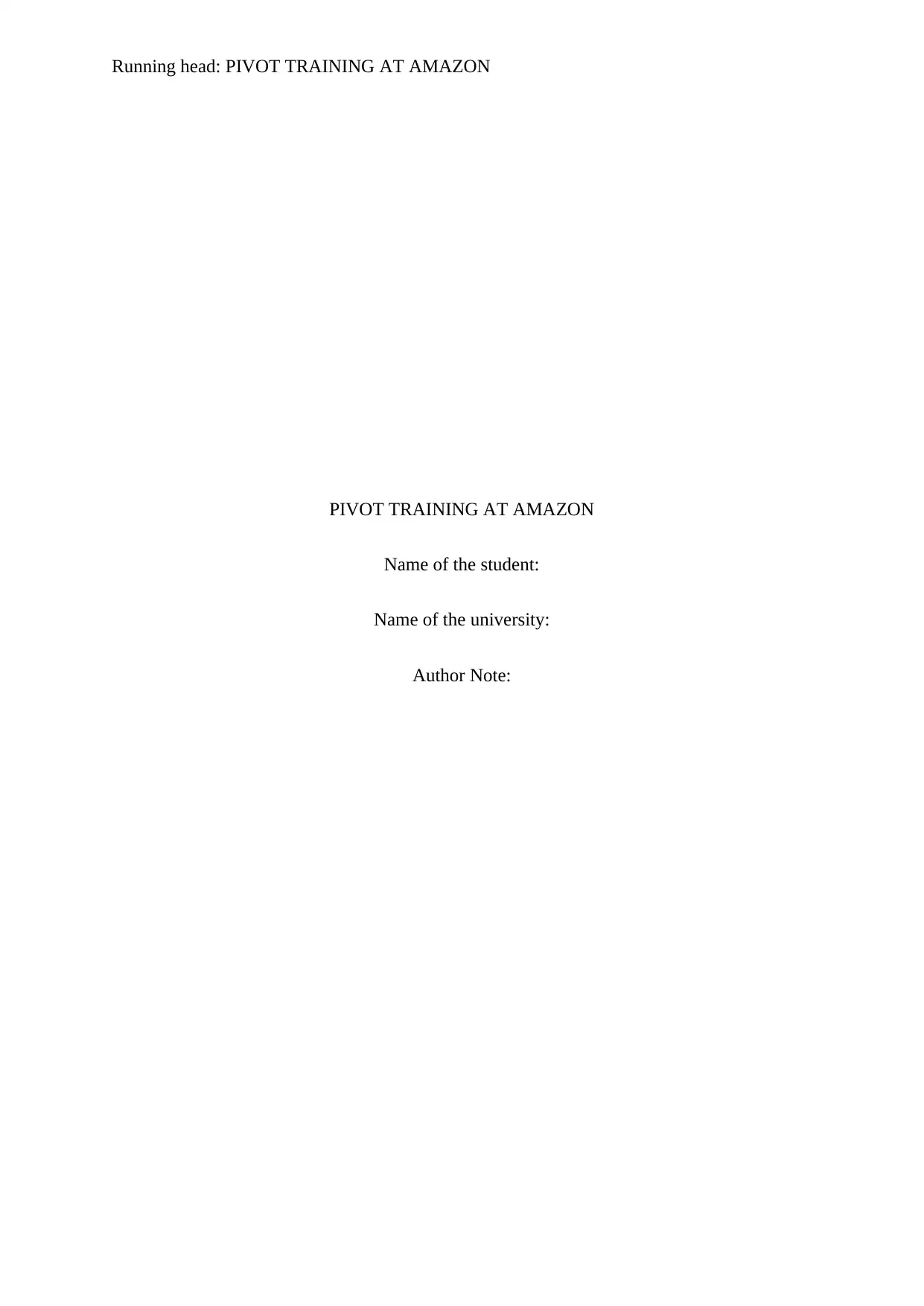
Running head: PIVOT TRAINING AT AMAZON
PIVOT TRAINING AT AMAZON
Name of the student:
Name of the university:
Author Note:
PIVOT TRAINING AT AMAZON
Name of the student:
Name of the university:
Author Note:
Paraphrase This Document
Need a fresh take? Get an instant paraphrase of this document with our AI Paraphraser
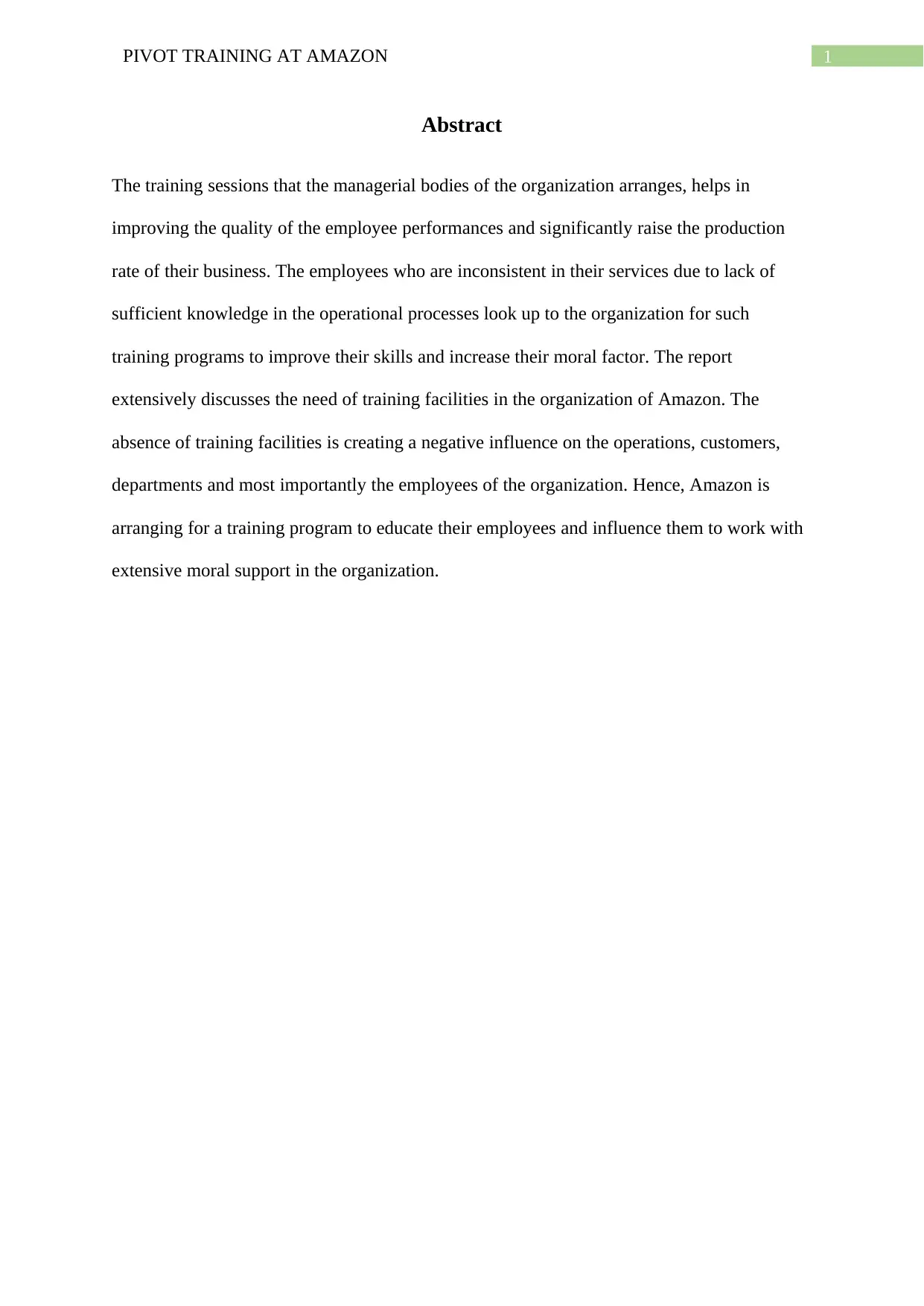
1PIVOT TRAINING AT AMAZON
Abstract
The training sessions that the managerial bodies of the organization arranges, helps in
improving the quality of the employee performances and significantly raise the production
rate of their business. The employees who are inconsistent in their services due to lack of
sufficient knowledge in the operational processes look up to the organization for such
training programs to improve their skills and increase their moral factor. The report
extensively discusses the need of training facilities in the organization of Amazon. The
absence of training facilities is creating a negative influence on the operations, customers,
departments and most importantly the employees of the organization. Hence, Amazon is
arranging for a training program to educate their employees and influence them to work with
extensive moral support in the organization.
Abstract
The training sessions that the managerial bodies of the organization arranges, helps in
improving the quality of the employee performances and significantly raise the production
rate of their business. The employees who are inconsistent in their services due to lack of
sufficient knowledge in the operational processes look up to the organization for such
training programs to improve their skills and increase their moral factor. The report
extensively discusses the need of training facilities in the organization of Amazon. The
absence of training facilities is creating a negative influence on the operations, customers,
departments and most importantly the employees of the organization. Hence, Amazon is
arranging for a training program to educate their employees and influence them to work with
extensive moral support in the organization.
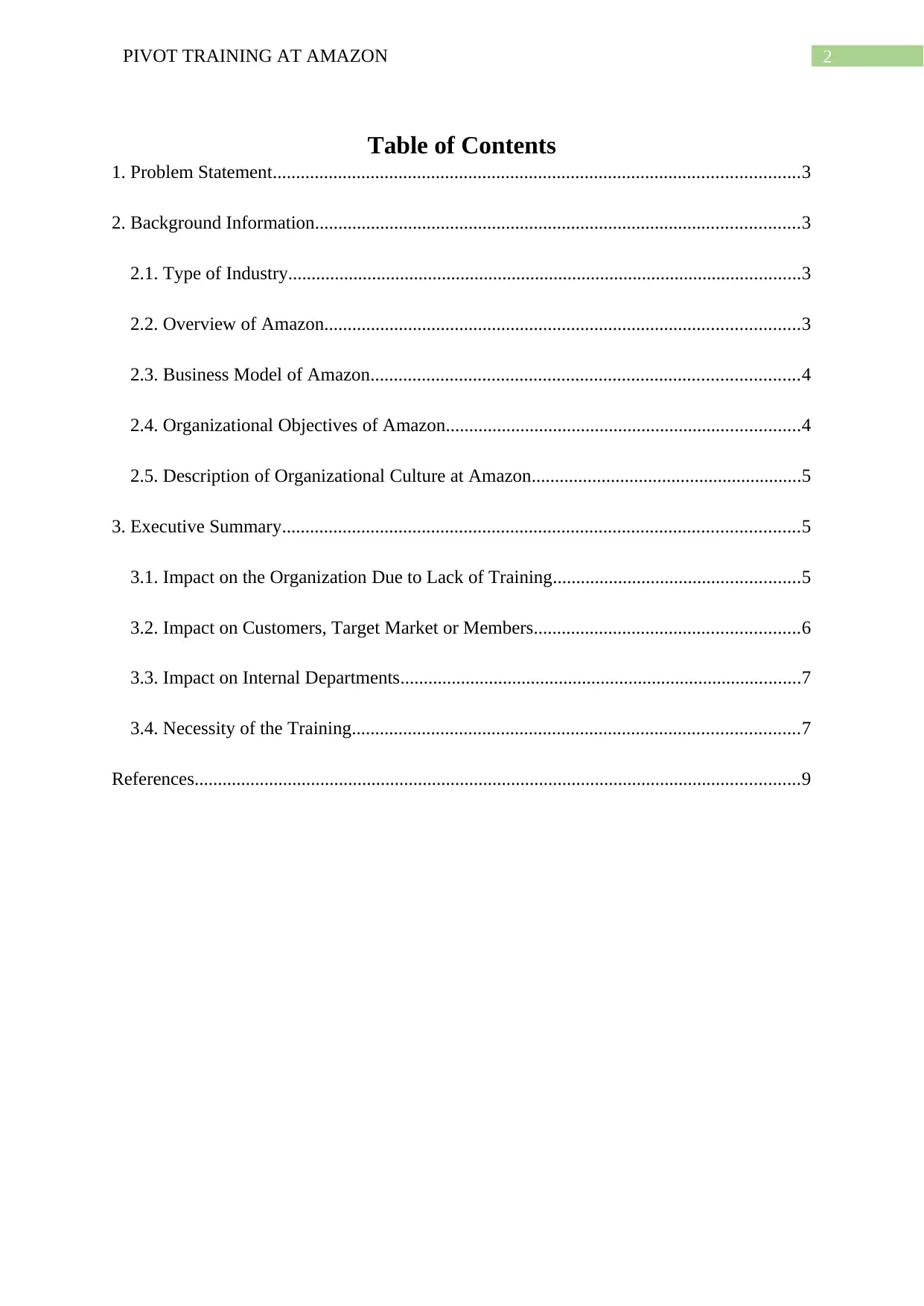
2PIVOT TRAINING AT AMAZON
Table of Contents
1. Problem Statement.................................................................................................................3
2. Background Information........................................................................................................3
2.1. Type of Industry..............................................................................................................3
2.2. Overview of Amazon......................................................................................................3
2.3. Business Model of Amazon............................................................................................4
2.4. Organizational Objectives of Amazon............................................................................4
2.5. Description of Organizational Culture at Amazon..........................................................5
3. Executive Summary...............................................................................................................5
3.1. Impact on the Organization Due to Lack of Training.....................................................5
3.2. Impact on Customers, Target Market or Members.........................................................6
3.3. Impact on Internal Departments......................................................................................7
3.4. Necessity of the Training................................................................................................7
References..................................................................................................................................9
Table of Contents
1. Problem Statement.................................................................................................................3
2. Background Information........................................................................................................3
2.1. Type of Industry..............................................................................................................3
2.2. Overview of Amazon......................................................................................................3
2.3. Business Model of Amazon............................................................................................4
2.4. Organizational Objectives of Amazon............................................................................4
2.5. Description of Organizational Culture at Amazon..........................................................5
3. Executive Summary...............................................................................................................5
3.1. Impact on the Organization Due to Lack of Training.....................................................5
3.2. Impact on Customers, Target Market or Members.........................................................6
3.3. Impact on Internal Departments......................................................................................7
3.4. Necessity of the Training................................................................................................7
References..................................................................................................................................9
⊘ This is a preview!⊘
Do you want full access?
Subscribe today to unlock all pages.

Trusted by 1+ million students worldwide
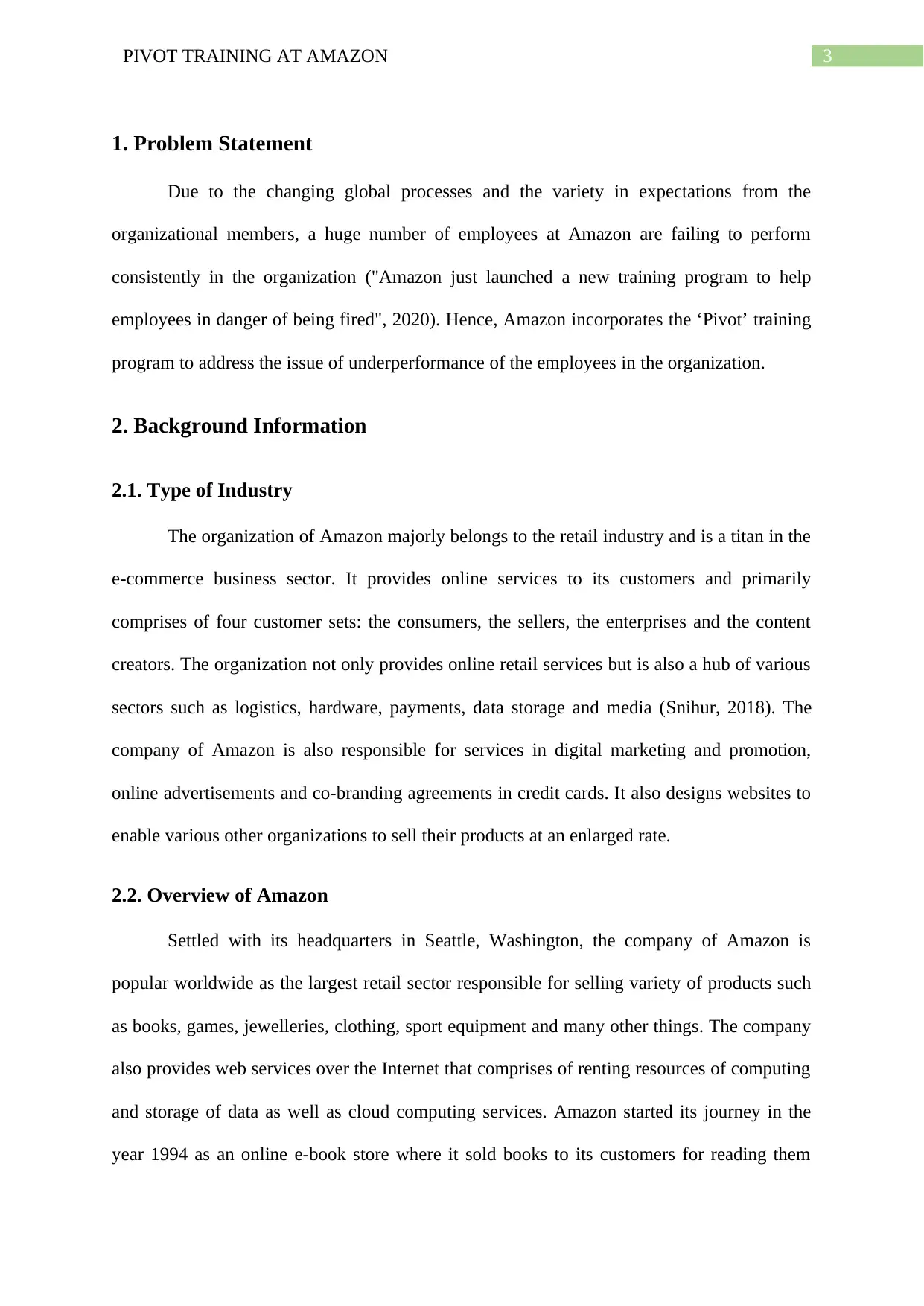
3PIVOT TRAINING AT AMAZON
1. Problem Statement
Due to the changing global processes and the variety in expectations from the
organizational members, a huge number of employees at Amazon are failing to perform
consistently in the organization ("Amazon just launched a new training program to help
employees in danger of being fired", 2020). Hence, Amazon incorporates the ‘Pivot’ training
program to address the issue of underperformance of the employees in the organization.
2. Background Information
2.1. Type of Industry
The organization of Amazon majorly belongs to the retail industry and is a titan in the
e-commerce business sector. It provides online services to its customers and primarily
comprises of four customer sets: the consumers, the sellers, the enterprises and the content
creators. The organization not only provides online retail services but is also a hub of various
sectors such as logistics, hardware, payments, data storage and media (Snihur, 2018). The
company of Amazon is also responsible for services in digital marketing and promotion,
online advertisements and co-branding agreements in credit cards. It also designs websites to
enable various other organizations to sell their products at an enlarged rate.
2.2. Overview of Amazon
Settled with its headquarters in Seattle, Washington, the company of Amazon is
popular worldwide as the largest retail sector responsible for selling variety of products such
as books, games, jewelleries, clothing, sport equipment and many other things. The company
also provides web services over the Internet that comprises of renting resources of computing
and storage of data as well as cloud computing services. Amazon started its journey in the
year 1994 as an online e-book store where it sold books to its customers for reading them
1. Problem Statement
Due to the changing global processes and the variety in expectations from the
organizational members, a huge number of employees at Amazon are failing to perform
consistently in the organization ("Amazon just launched a new training program to help
employees in danger of being fired", 2020). Hence, Amazon incorporates the ‘Pivot’ training
program to address the issue of underperformance of the employees in the organization.
2. Background Information
2.1. Type of Industry
The organization of Amazon majorly belongs to the retail industry and is a titan in the
e-commerce business sector. It provides online services to its customers and primarily
comprises of four customer sets: the consumers, the sellers, the enterprises and the content
creators. The organization not only provides online retail services but is also a hub of various
sectors such as logistics, hardware, payments, data storage and media (Snihur, 2018). The
company of Amazon is also responsible for services in digital marketing and promotion,
online advertisements and co-branding agreements in credit cards. It also designs websites to
enable various other organizations to sell their products at an enlarged rate.
2.2. Overview of Amazon
Settled with its headquarters in Seattle, Washington, the company of Amazon is
popular worldwide as the largest retail sector responsible for selling variety of products such
as books, games, jewelleries, clothing, sport equipment and many other things. The company
also provides web services over the Internet that comprises of renting resources of computing
and storage of data as well as cloud computing services. Amazon started its journey in the
year 1994 as an online e-book store where it sold books to its customers for reading them
Paraphrase This Document
Need a fresh take? Get an instant paraphrase of this document with our AI Paraphraser
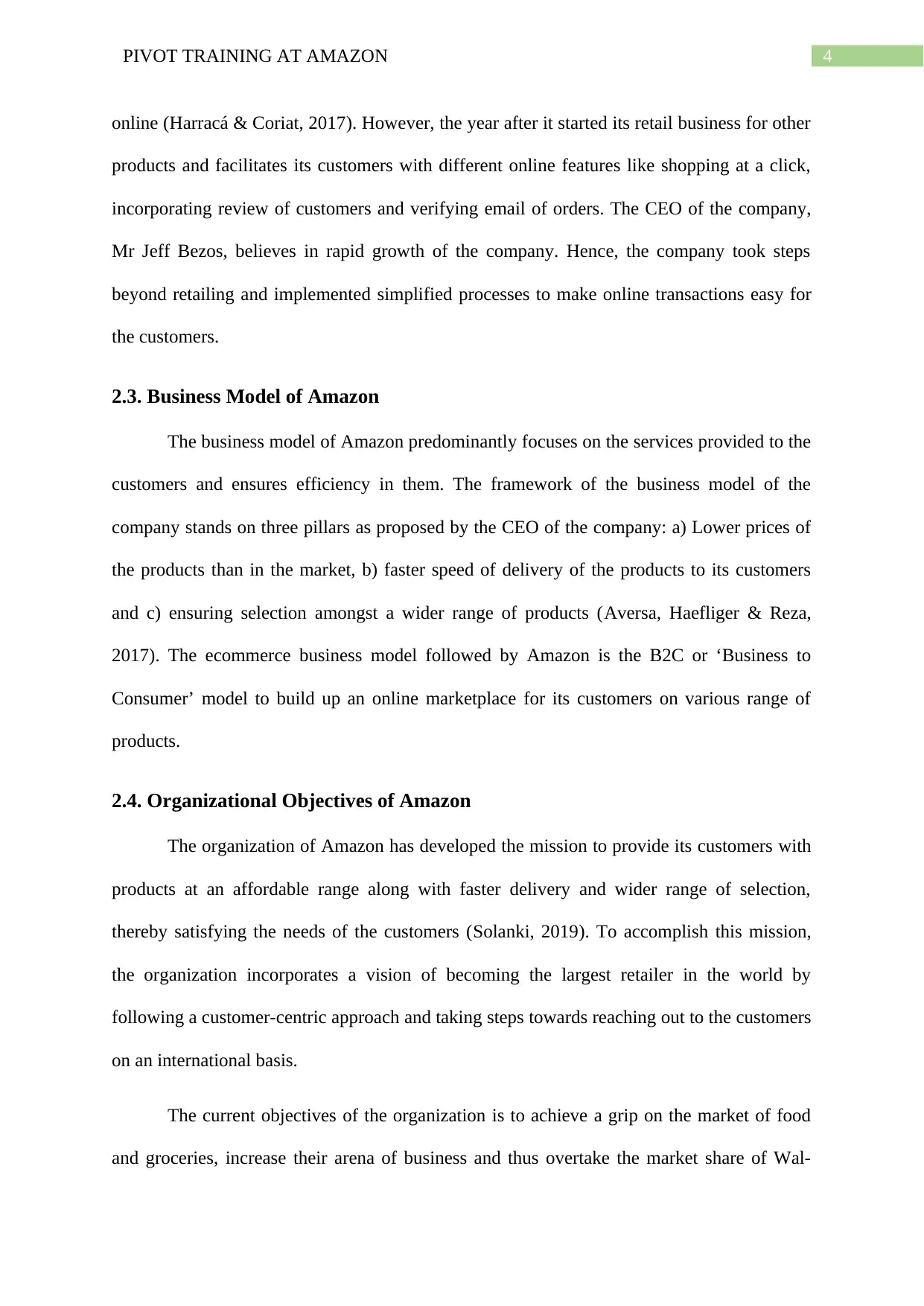
4PIVOT TRAINING AT AMAZON
online (Harracá & Coriat, 2017). However, the year after it started its retail business for other
products and facilitates its customers with different online features like shopping at a click,
incorporating review of customers and verifying email of orders. The CEO of the company,
Mr Jeff Bezos, believes in rapid growth of the company. Hence, the company took steps
beyond retailing and implemented simplified processes to make online transactions easy for
the customers.
2.3. Business Model of Amazon
The business model of Amazon predominantly focuses on the services provided to the
customers and ensures efficiency in them. The framework of the business model of the
company stands on three pillars as proposed by the CEO of the company: a) Lower prices of
the products than in the market, b) faster speed of delivery of the products to its customers
and c) ensuring selection amongst a wider range of products (Aversa, Haefliger & Reza,
2017). The ecommerce business model followed by Amazon is the B2C or ‘Business to
Consumer’ model to build up an online marketplace for its customers on various range of
products.
2.4. Organizational Objectives of Amazon
The organization of Amazon has developed the mission to provide its customers with
products at an affordable range along with faster delivery and wider range of selection,
thereby satisfying the needs of the customers (Solanki, 2019). To accomplish this mission,
the organization incorporates a vision of becoming the largest retailer in the world by
following a customer-centric approach and taking steps towards reaching out to the customers
on an international basis.
The current objectives of the organization is to achieve a grip on the market of food
and groceries, increase their arena of business and thus overtake the market share of Wal-
online (Harracá & Coriat, 2017). However, the year after it started its retail business for other
products and facilitates its customers with different online features like shopping at a click,
incorporating review of customers and verifying email of orders. The CEO of the company,
Mr Jeff Bezos, believes in rapid growth of the company. Hence, the company took steps
beyond retailing and implemented simplified processes to make online transactions easy for
the customers.
2.3. Business Model of Amazon
The business model of Amazon predominantly focuses on the services provided to the
customers and ensures efficiency in them. The framework of the business model of the
company stands on three pillars as proposed by the CEO of the company: a) Lower prices of
the products than in the market, b) faster speed of delivery of the products to its customers
and c) ensuring selection amongst a wider range of products (Aversa, Haefliger & Reza,
2017). The ecommerce business model followed by Amazon is the B2C or ‘Business to
Consumer’ model to build up an online marketplace for its customers on various range of
products.
2.4. Organizational Objectives of Amazon
The organization of Amazon has developed the mission to provide its customers with
products at an affordable range along with faster delivery and wider range of selection,
thereby satisfying the needs of the customers (Solanki, 2019). To accomplish this mission,
the organization incorporates a vision of becoming the largest retailer in the world by
following a customer-centric approach and taking steps towards reaching out to the customers
on an international basis.
The current objectives of the organization is to achieve a grip on the market of food
and groceries, increase their arena of business and thus overtake the market share of Wal-
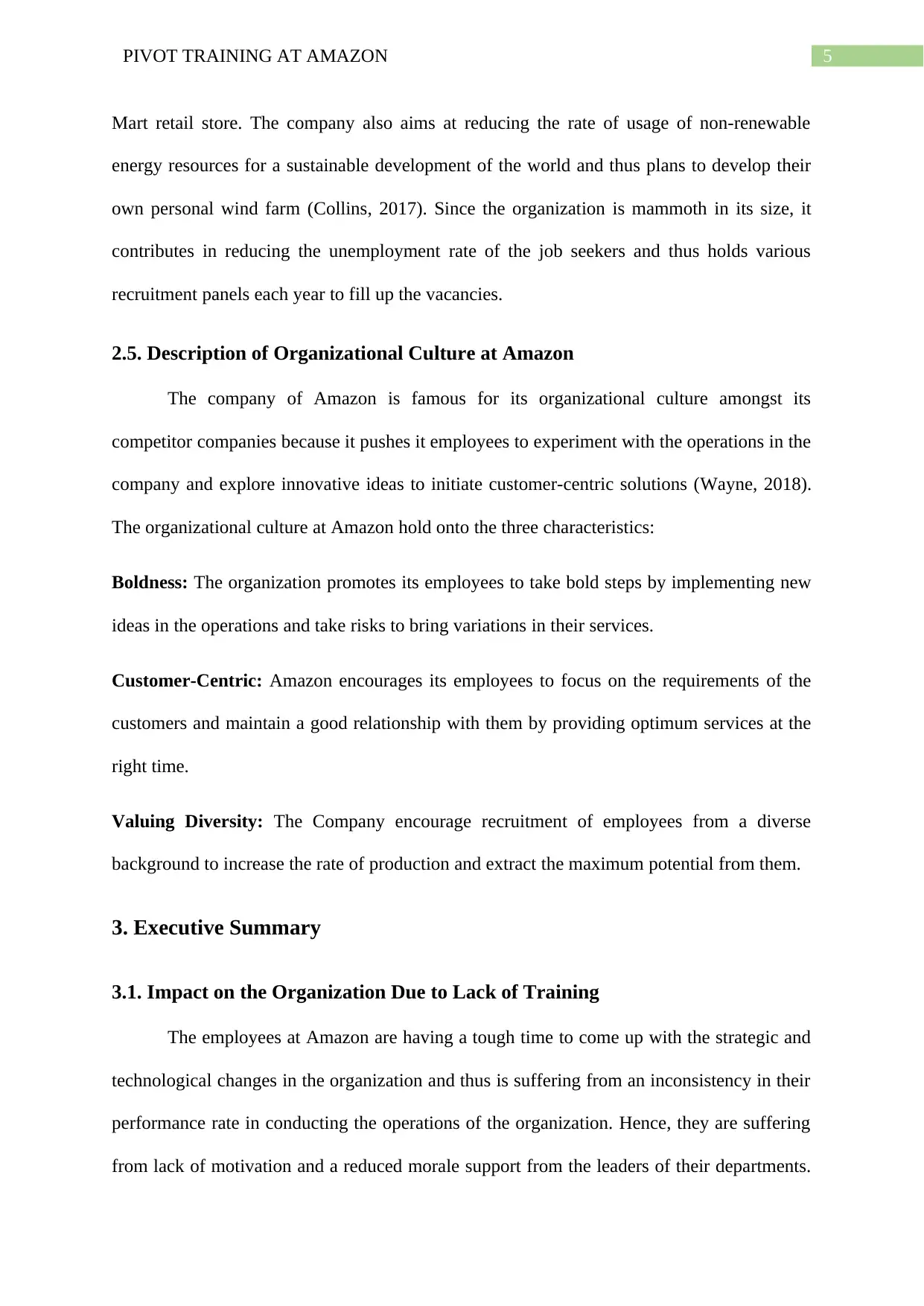
5PIVOT TRAINING AT AMAZON
Mart retail store. The company also aims at reducing the rate of usage of non-renewable
energy resources for a sustainable development of the world and thus plans to develop their
own personal wind farm (Collins, 2017). Since the organization is mammoth in its size, it
contributes in reducing the unemployment rate of the job seekers and thus holds various
recruitment panels each year to fill up the vacancies.
2.5. Description of Organizational Culture at Amazon
The company of Amazon is famous for its organizational culture amongst its
competitor companies because it pushes it employees to experiment with the operations in the
company and explore innovative ideas to initiate customer-centric solutions (Wayne, 2018).
The organizational culture at Amazon hold onto the three characteristics:
Boldness: The organization promotes its employees to take bold steps by implementing new
ideas in the operations and take risks to bring variations in their services.
Customer-Centric: Amazon encourages its employees to focus on the requirements of the
customers and maintain a good relationship with them by providing optimum services at the
right time.
Valuing Diversity: The Company encourage recruitment of employees from a diverse
background to increase the rate of production and extract the maximum potential from them.
3. Executive Summary
3.1. Impact on the Organization Due to Lack of Training
The employees at Amazon are having a tough time to come up with the strategic and
technological changes in the organization and thus is suffering from an inconsistency in their
performance rate in conducting the operations of the organization. Hence, they are suffering
from lack of motivation and a reduced morale support from the leaders of their departments.
Mart retail store. The company also aims at reducing the rate of usage of non-renewable
energy resources for a sustainable development of the world and thus plans to develop their
own personal wind farm (Collins, 2017). Since the organization is mammoth in its size, it
contributes in reducing the unemployment rate of the job seekers and thus holds various
recruitment panels each year to fill up the vacancies.
2.5. Description of Organizational Culture at Amazon
The company of Amazon is famous for its organizational culture amongst its
competitor companies because it pushes it employees to experiment with the operations in the
company and explore innovative ideas to initiate customer-centric solutions (Wayne, 2018).
The organizational culture at Amazon hold onto the three characteristics:
Boldness: The organization promotes its employees to take bold steps by implementing new
ideas in the operations and take risks to bring variations in their services.
Customer-Centric: Amazon encourages its employees to focus on the requirements of the
customers and maintain a good relationship with them by providing optimum services at the
right time.
Valuing Diversity: The Company encourage recruitment of employees from a diverse
background to increase the rate of production and extract the maximum potential from them.
3. Executive Summary
3.1. Impact on the Organization Due to Lack of Training
The employees at Amazon are having a tough time to come up with the strategic and
technological changes in the organization and thus is suffering from an inconsistency in their
performance rate in conducting the operations of the organization. Hence, they are suffering
from lack of motivation and a reduced morale support from the leaders of their departments.
⊘ This is a preview!⊘
Do you want full access?
Subscribe today to unlock all pages.

Trusted by 1+ million students worldwide
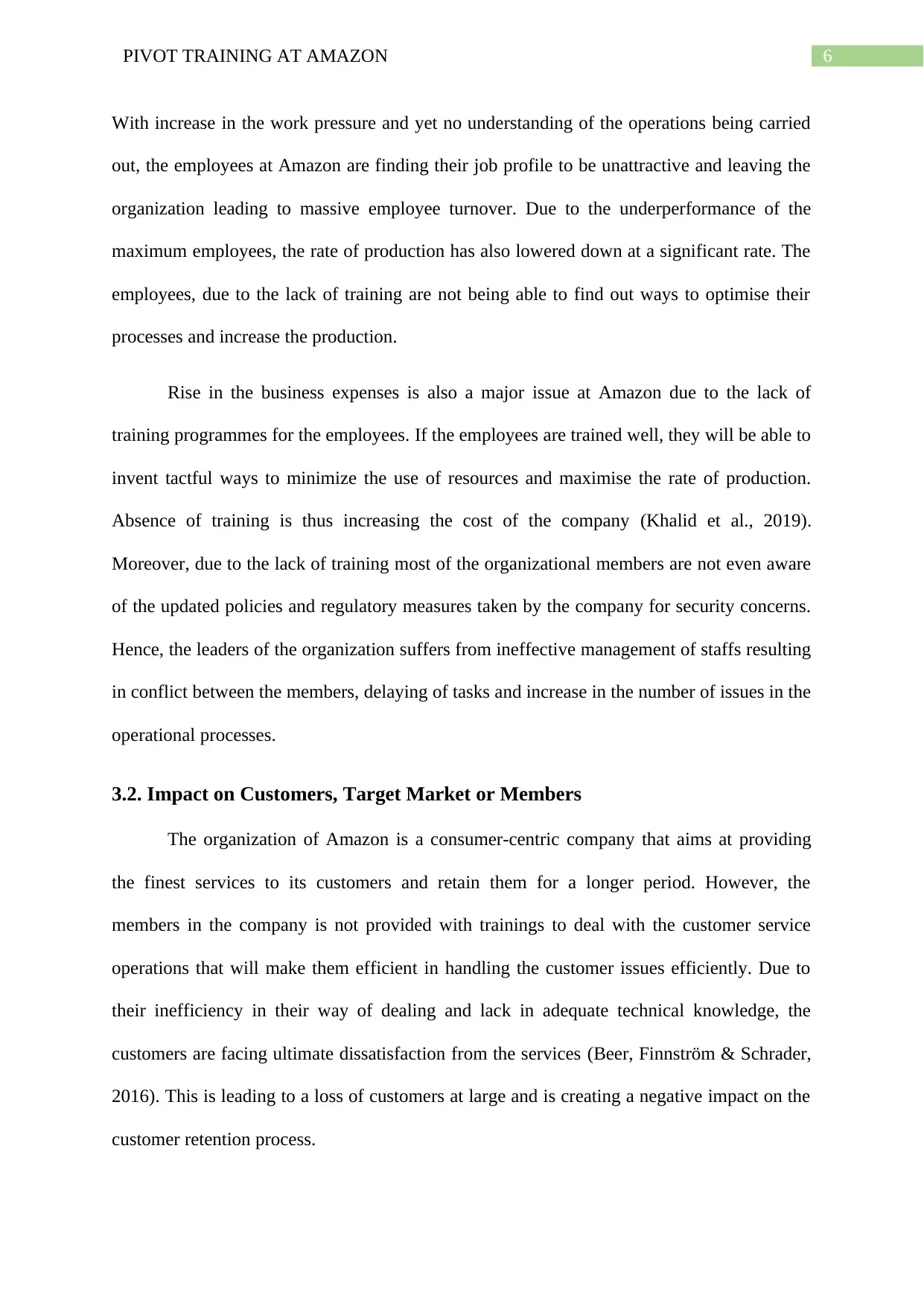
6PIVOT TRAINING AT AMAZON
With increase in the work pressure and yet no understanding of the operations being carried
out, the employees at Amazon are finding their job profile to be unattractive and leaving the
organization leading to massive employee turnover. Due to the underperformance of the
maximum employees, the rate of production has also lowered down at a significant rate. The
employees, due to the lack of training are not being able to find out ways to optimise their
processes and increase the production.
Rise in the business expenses is also a major issue at Amazon due to the lack of
training programmes for the employees. If the employees are trained well, they will be able to
invent tactful ways to minimize the use of resources and maximise the rate of production.
Absence of training is thus increasing the cost of the company (Khalid et al., 2019).
Moreover, due to the lack of training most of the organizational members are not even aware
of the updated policies and regulatory measures taken by the company for security concerns.
Hence, the leaders of the organization suffers from ineffective management of staffs resulting
in conflict between the members, delaying of tasks and increase in the number of issues in the
operational processes.
3.2. Impact on Customers, Target Market or Members
The organization of Amazon is a consumer-centric company that aims at providing
the finest services to its customers and retain them for a longer period. However, the
members in the company is not provided with trainings to deal with the customer service
operations that will make them efficient in handling the customer issues efficiently. Due to
their inefficiency in their way of dealing and lack in adequate technical knowledge, the
customers are facing ultimate dissatisfaction from the services (Beer, Finnström & Schrader,
2016). This is leading to a loss of customers at large and is creating a negative impact on the
customer retention process.
With increase in the work pressure and yet no understanding of the operations being carried
out, the employees at Amazon are finding their job profile to be unattractive and leaving the
organization leading to massive employee turnover. Due to the underperformance of the
maximum employees, the rate of production has also lowered down at a significant rate. The
employees, due to the lack of training are not being able to find out ways to optimise their
processes and increase the production.
Rise in the business expenses is also a major issue at Amazon due to the lack of
training programmes for the employees. If the employees are trained well, they will be able to
invent tactful ways to minimize the use of resources and maximise the rate of production.
Absence of training is thus increasing the cost of the company (Khalid et al., 2019).
Moreover, due to the lack of training most of the organizational members are not even aware
of the updated policies and regulatory measures taken by the company for security concerns.
Hence, the leaders of the organization suffers from ineffective management of staffs resulting
in conflict between the members, delaying of tasks and increase in the number of issues in the
operational processes.
3.2. Impact on Customers, Target Market or Members
The organization of Amazon is a consumer-centric company that aims at providing
the finest services to its customers and retain them for a longer period. However, the
members in the company is not provided with trainings to deal with the customer service
operations that will make them efficient in handling the customer issues efficiently. Due to
their inefficiency in their way of dealing and lack in adequate technical knowledge, the
customers are facing ultimate dissatisfaction from the services (Beer, Finnström & Schrader,
2016). This is leading to a loss of customers at large and is creating a negative impact on the
customer retention process.
Paraphrase This Document
Need a fresh take? Get an instant paraphrase of this document with our AI Paraphraser
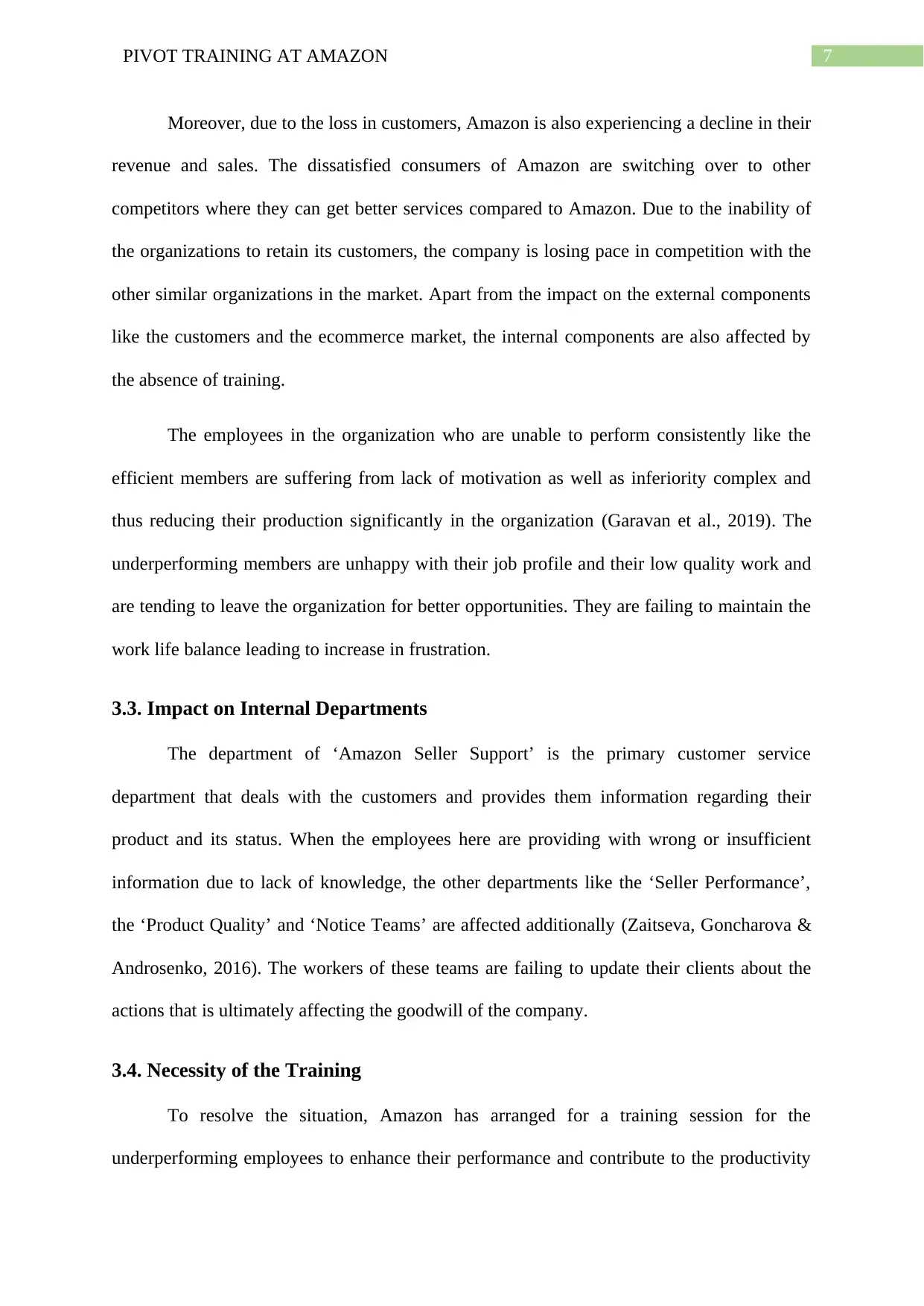
7PIVOT TRAINING AT AMAZON
Moreover, due to the loss in customers, Amazon is also experiencing a decline in their
revenue and sales. The dissatisfied consumers of Amazon are switching over to other
competitors where they can get better services compared to Amazon. Due to the inability of
the organizations to retain its customers, the company is losing pace in competition with the
other similar organizations in the market. Apart from the impact on the external components
like the customers and the ecommerce market, the internal components are also affected by
the absence of training.
The employees in the organization who are unable to perform consistently like the
efficient members are suffering from lack of motivation as well as inferiority complex and
thus reducing their production significantly in the organization (Garavan et al., 2019). The
underperforming members are unhappy with their job profile and their low quality work and
are tending to leave the organization for better opportunities. They are failing to maintain the
work life balance leading to increase in frustration.
3.3. Impact on Internal Departments
The department of ‘Amazon Seller Support’ is the primary customer service
department that deals with the customers and provides them information regarding their
product and its status. When the employees here are providing with wrong or insufficient
information due to lack of knowledge, the other departments like the ‘Seller Performance’,
the ‘Product Quality’ and ‘Notice Teams’ are affected additionally (Zaitseva, Goncharova &
Androsenko, 2016). The workers of these teams are failing to update their clients about the
actions that is ultimately affecting the goodwill of the company.
3.4. Necessity of the Training
To resolve the situation, Amazon has arranged for a training session for the
underperforming employees to enhance their performance and contribute to the productivity
Moreover, due to the loss in customers, Amazon is also experiencing a decline in their
revenue and sales. The dissatisfied consumers of Amazon are switching over to other
competitors where they can get better services compared to Amazon. Due to the inability of
the organizations to retain its customers, the company is losing pace in competition with the
other similar organizations in the market. Apart from the impact on the external components
like the customers and the ecommerce market, the internal components are also affected by
the absence of training.
The employees in the organization who are unable to perform consistently like the
efficient members are suffering from lack of motivation as well as inferiority complex and
thus reducing their production significantly in the organization (Garavan et al., 2019). The
underperforming members are unhappy with their job profile and their low quality work and
are tending to leave the organization for better opportunities. They are failing to maintain the
work life balance leading to increase in frustration.
3.3. Impact on Internal Departments
The department of ‘Amazon Seller Support’ is the primary customer service
department that deals with the customers and provides them information regarding their
product and its status. When the employees here are providing with wrong or insufficient
information due to lack of knowledge, the other departments like the ‘Seller Performance’,
the ‘Product Quality’ and ‘Notice Teams’ are affected additionally (Zaitseva, Goncharova &
Androsenko, 2016). The workers of these teams are failing to update their clients about the
actions that is ultimately affecting the goodwill of the company.
3.4. Necessity of the Training
To resolve the situation, Amazon has arranged for a training session for the
underperforming employees to enhance their performance and contribute to the productivity
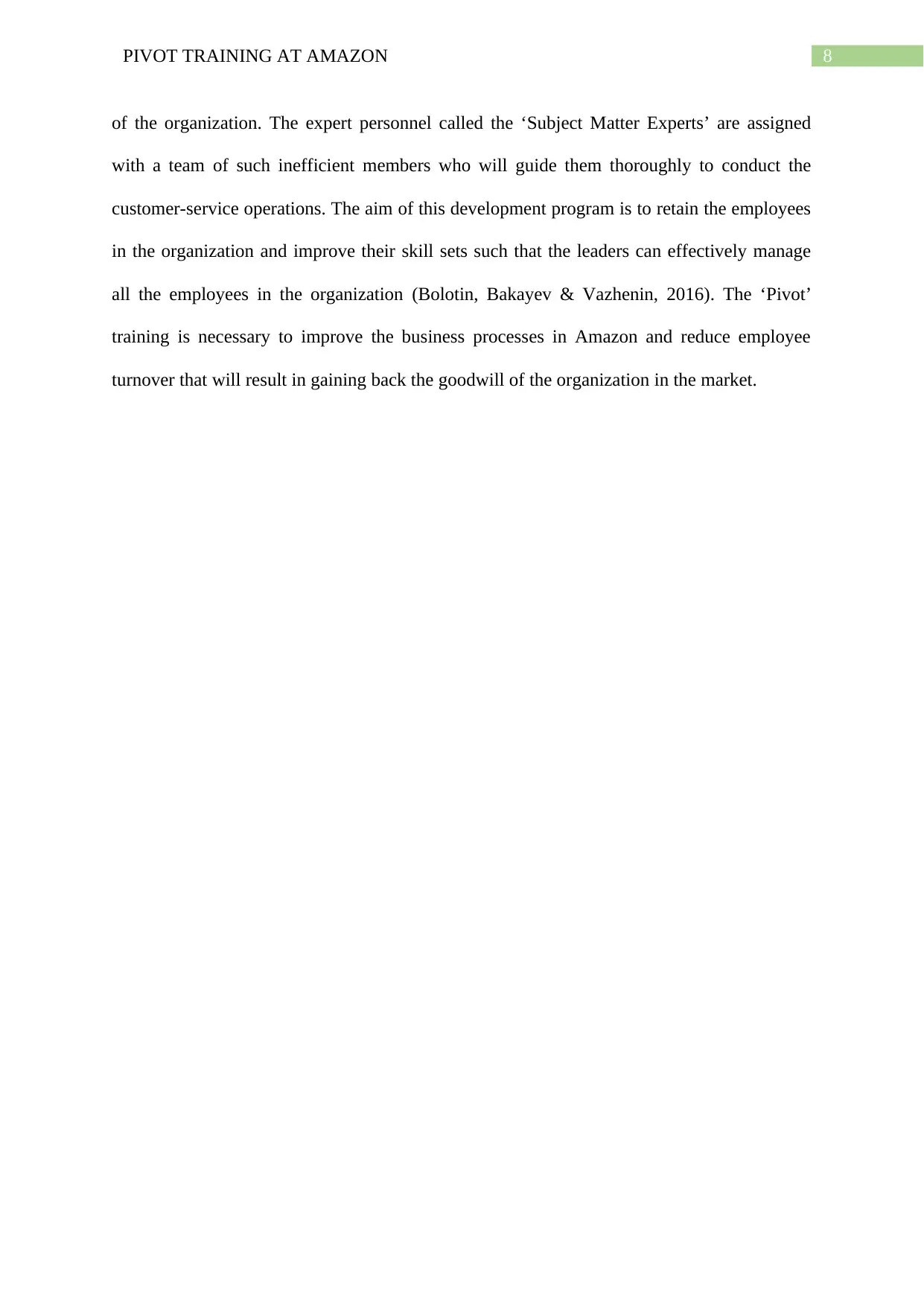
8PIVOT TRAINING AT AMAZON
of the organization. The expert personnel called the ‘Subject Matter Experts’ are assigned
with a team of such inefficient members who will guide them thoroughly to conduct the
customer-service operations. The aim of this development program is to retain the employees
in the organization and improve their skill sets such that the leaders can effectively manage
all the employees in the organization (Bolotin, Bakayev & Vazhenin, 2016). The ‘Pivot’
training is necessary to improve the business processes in Amazon and reduce employee
turnover that will result in gaining back the goodwill of the organization in the market.
of the organization. The expert personnel called the ‘Subject Matter Experts’ are assigned
with a team of such inefficient members who will guide them thoroughly to conduct the
customer-service operations. The aim of this development program is to retain the employees
in the organization and improve their skill sets such that the leaders can effectively manage
all the employees in the organization (Bolotin, Bakayev & Vazhenin, 2016). The ‘Pivot’
training is necessary to improve the business processes in Amazon and reduce employee
turnover that will result in gaining back the goodwill of the organization in the market.
⊘ This is a preview!⊘
Do you want full access?
Subscribe today to unlock all pages.

Trusted by 1+ million students worldwide
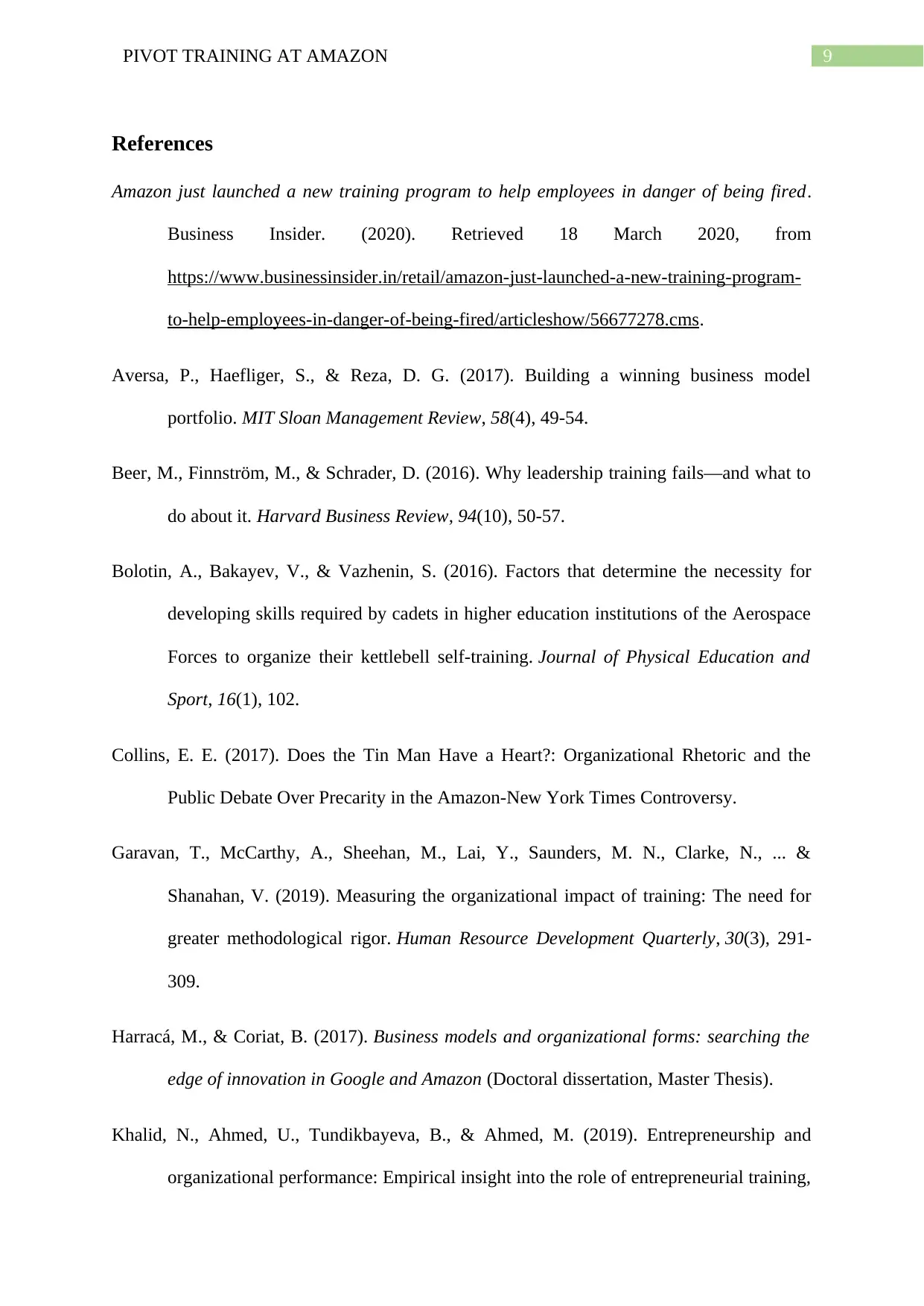
9PIVOT TRAINING AT AMAZON
References
Amazon just launched a new training program to help employees in danger of being fired.
Business Insider. (2020). Retrieved 18 March 2020, from
https://www.businessinsider.in/retail/amazon-just-launched-a-new-training-program-
to-help-employees-in-danger-of-being-fired/articleshow/56677278.cms.
Aversa, P., Haefliger, S., & Reza, D. G. (2017). Building a winning business model
portfolio. MIT Sloan Management Review, 58(4), 49-54.
Beer, M., Finnström, M., & Schrader, D. (2016). Why leadership training fails—and what to
do about it. Harvard Business Review, 94(10), 50-57.
Bolotin, A., Bakayev, V., & Vazhenin, S. (2016). Factors that determine the necessity for
developing skills required by cadets in higher education institutions of the Aerospace
Forces to organize their kettlebell self-training. Journal of Physical Education and
Sport, 16(1), 102.
Collins, E. E. (2017). Does the Tin Man Have a Heart?: Organizational Rhetoric and the
Public Debate Over Precarity in the Amazon-New York Times Controversy.
Garavan, T., McCarthy, A., Sheehan, M., Lai, Y., Saunders, M. N., Clarke, N., ... &
Shanahan, V. (2019). Measuring the organizational impact of training: The need for
greater methodological rigor. Human Resource Development Quarterly, 30(3), 291-
309.
Harracá, M., & Coriat, B. (2017). Business models and organizational forms: searching the
edge of innovation in Google and Amazon (Doctoral dissertation, Master Thesis).
Khalid, N., Ahmed, U., Tundikbayeva, B., & Ahmed, M. (2019). Entrepreneurship and
organizational performance: Empirical insight into the role of entrepreneurial training,
References
Amazon just launched a new training program to help employees in danger of being fired.
Business Insider. (2020). Retrieved 18 March 2020, from
https://www.businessinsider.in/retail/amazon-just-launched-a-new-training-program-
to-help-employees-in-danger-of-being-fired/articleshow/56677278.cms.
Aversa, P., Haefliger, S., & Reza, D. G. (2017). Building a winning business model
portfolio. MIT Sloan Management Review, 58(4), 49-54.
Beer, M., Finnström, M., & Schrader, D. (2016). Why leadership training fails—and what to
do about it. Harvard Business Review, 94(10), 50-57.
Bolotin, A., Bakayev, V., & Vazhenin, S. (2016). Factors that determine the necessity for
developing skills required by cadets in higher education institutions of the Aerospace
Forces to organize their kettlebell self-training. Journal of Physical Education and
Sport, 16(1), 102.
Collins, E. E. (2017). Does the Tin Man Have a Heart?: Organizational Rhetoric and the
Public Debate Over Precarity in the Amazon-New York Times Controversy.
Garavan, T., McCarthy, A., Sheehan, M., Lai, Y., Saunders, M. N., Clarke, N., ... &
Shanahan, V. (2019). Measuring the organizational impact of training: The need for
greater methodological rigor. Human Resource Development Quarterly, 30(3), 291-
309.
Harracá, M., & Coriat, B. (2017). Business models and organizational forms: searching the
edge of innovation in Google and Amazon (Doctoral dissertation, Master Thesis).
Khalid, N., Ahmed, U., Tundikbayeva, B., & Ahmed, M. (2019). Entrepreneurship and
organizational performance: Empirical insight into the role of entrepreneurial training,
Paraphrase This Document
Need a fresh take? Get an instant paraphrase of this document with our AI Paraphraser
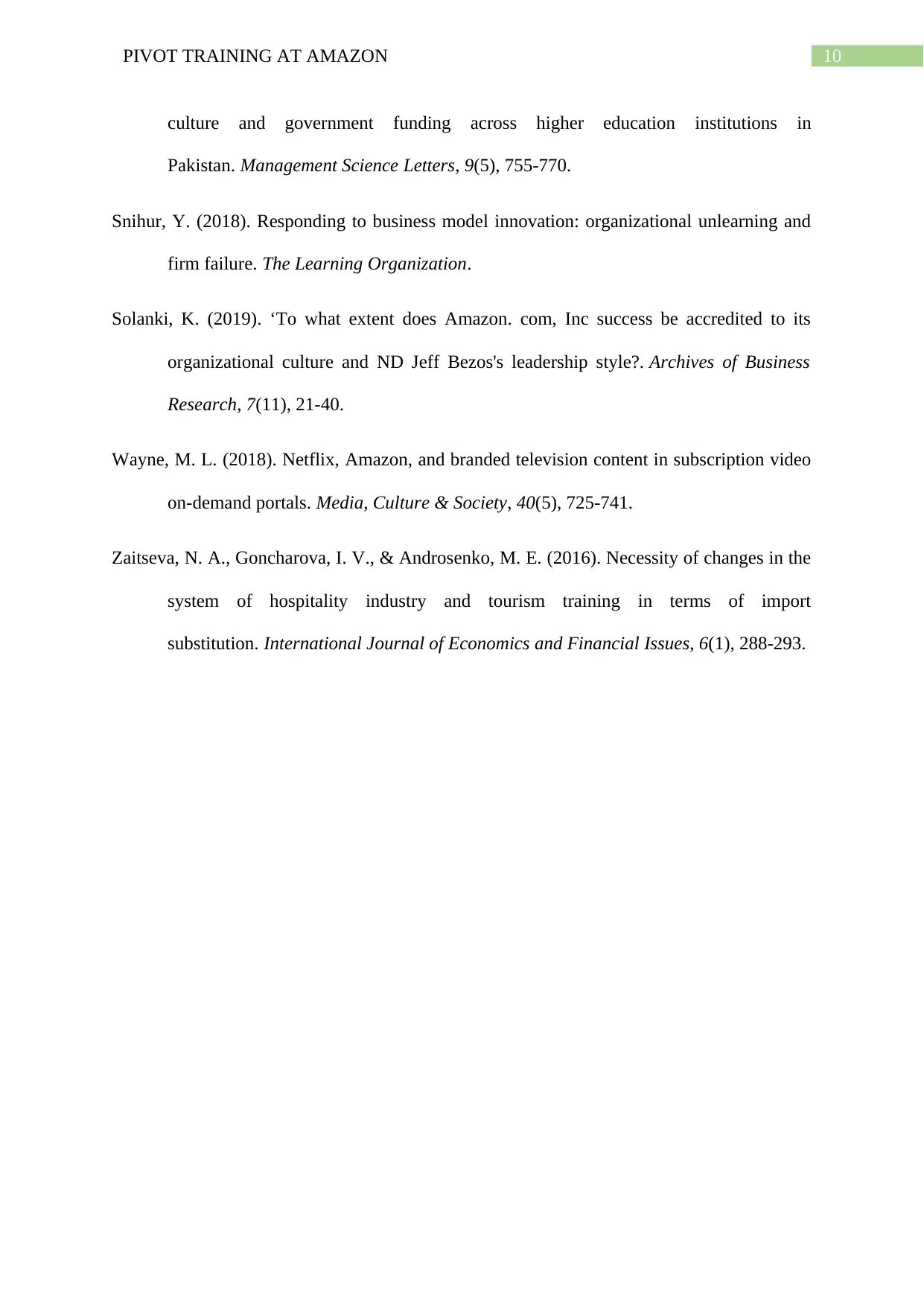
10PIVOT TRAINING AT AMAZON
culture and government funding across higher education institutions in
Pakistan. Management Science Letters, 9(5), 755-770.
Snihur, Y. (2018). Responding to business model innovation: organizational unlearning and
firm failure. The Learning Organization.
Solanki, K. (2019). ‘To what extent does Amazon. com, Inc success be accredited to its
organizational culture and ND Jeff Bezos's leadership style?. Archives of Business
Research, 7(11), 21-40.
Wayne, M. L. (2018). Netflix, Amazon, and branded television content in subscription video
on-demand portals. Media, Culture & Society, 40(5), 725-741.
Zaitseva, N. A., Goncharova, I. V., & Androsenko, M. E. (2016). Necessity of changes in the
system of hospitality industry and tourism training in terms of import
substitution. International Journal of Economics and Financial Issues, 6(1), 288-293.
culture and government funding across higher education institutions in
Pakistan. Management Science Letters, 9(5), 755-770.
Snihur, Y. (2018). Responding to business model innovation: organizational unlearning and
firm failure. The Learning Organization.
Solanki, K. (2019). ‘To what extent does Amazon. com, Inc success be accredited to its
organizational culture and ND Jeff Bezos's leadership style?. Archives of Business
Research, 7(11), 21-40.
Wayne, M. L. (2018). Netflix, Amazon, and branded television content in subscription video
on-demand portals. Media, Culture & Society, 40(5), 725-741.
Zaitseva, N. A., Goncharova, I. V., & Androsenko, M. E. (2016). Necessity of changes in the
system of hospitality industry and tourism training in terms of import
substitution. International Journal of Economics and Financial Issues, 6(1), 288-293.
1 out of 11
Related Documents
Your All-in-One AI-Powered Toolkit for Academic Success.
+13062052269
info@desklib.com
Available 24*7 on WhatsApp / Email
![[object Object]](/_next/static/media/star-bottom.7253800d.svg)
Unlock your academic potential
Copyright © 2020–2025 A2Z Services. All Rights Reserved. Developed and managed by ZUCOL.





